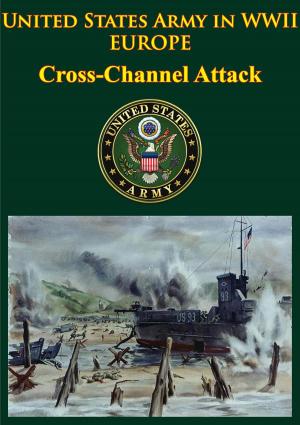United States Army in WWII - Europe - Riviera to the Rhine
[Illustrated Edition]
Nonfiction, History, Germany, European General, Military, United States| Author: | Robert Ross Smith, Jeffrey J. Clarke | ISBN: | 9781782894155 |
| Publisher: | Lucknow Books | Publication: | August 15, 2014 |
| Imprint: | Lucknow Books | Language: | English |
| Author: | Robert Ross Smith, Jeffrey J. Clarke |
| ISBN: | 9781782894155 |
| Publisher: | Lucknow Books |
| Publication: | August 15, 2014 |
| Imprint: | Lucknow Books |
| Language: | English |
[Includes 35 maps and 77 illustrations]
Riviera to the Rhine examines a significant portion of the Allied drive across northern Europe and focuses on the vital role played in that drive by the U.S. 6th Army Group, commanded by General Jacob L. Devers, and its two major components, the American Seventh Army, under General Alexander M. Patch, and the French First Army, under General Jean de Lattre de Tassigny. Had these forces not existed, Eisenhower’s two northern army groups, those commanded by Field Marshal Sir Bernard L. Montgomery and General Omar N. Bradley, would have been stretched much thinner, with their offensive and defensive capabilities greatly reduced. In such a case the German offensive of Dec. 1944 might have met with greater success, easily postponing the final Allied drive into Germany with unforeseen military and political consequences. Riviera thus should balance the greater public attention given to the commands of Montgomery and Bradley by concentrating on the accomplishments of those led by Devers, Patch, and de Lattre and, in the process, by highlighting the crucial logistical contributions of the southern French ports to the Allied war effort.
Finally Riviera is the study of a combined, Franco-American military effort, one which frequently saw major combat units of each nation commanded by generals of the other on the field of battle. Although outwardly similar, each national component had its own unique style, and a deep appreciation of one another’s strengths and weaknesses was vital to the success of the combined force. National political considerations also played a significant role in the operations of the combined force as did personal conflicts within both chains of command, all of which had to be resolved primarily by the principal commanders in the field.
[Includes 35 maps and 77 illustrations]
Riviera to the Rhine examines a significant portion of the Allied drive across northern Europe and focuses on the vital role played in that drive by the U.S. 6th Army Group, commanded by General Jacob L. Devers, and its two major components, the American Seventh Army, under General Alexander M. Patch, and the French First Army, under General Jean de Lattre de Tassigny. Had these forces not existed, Eisenhower’s two northern army groups, those commanded by Field Marshal Sir Bernard L. Montgomery and General Omar N. Bradley, would have been stretched much thinner, with their offensive and defensive capabilities greatly reduced. In such a case the German offensive of Dec. 1944 might have met with greater success, easily postponing the final Allied drive into Germany with unforeseen military and political consequences. Riviera thus should balance the greater public attention given to the commands of Montgomery and Bradley by concentrating on the accomplishments of those led by Devers, Patch, and de Lattre and, in the process, by highlighting the crucial logistical contributions of the southern French ports to the Allied war effort.
Finally Riviera is the study of a combined, Franco-American military effort, one which frequently saw major combat units of each nation commanded by generals of the other on the field of battle. Although outwardly similar, each national component had its own unique style, and a deep appreciation of one another’s strengths and weaknesses was vital to the success of the combined force. National political considerations also played a significant role in the operations of the combined force as did personal conflicts within both chains of command, all of which had to be resolved primarily by the principal commanders in the field.


![Cover of the book The Battle Of The Huertgen Forest [Illustrated Edition] by Robert Ross Smith, Jeffrey J. Clarke](https://www.kuoky.com/images/2014/august/300x300/9781782898481-IEdU_300x.jpg)


![Cover of the book UTAH BEACH TO CHERBOURG - 6-27 JUNE 1944 [Illustrated Edition] by Robert Ross Smith, Jeffrey J. Clarke](https://www.kuoky.com/images/2014/august/300x300/9781782892649-OpIQ_300x.jpg)

![Cover of the book On The Road To Kut, A Soldier’s Story Of The Mesopotamian Campaign [Illustrated Edition] by Robert Ross Smith, Jeffrey J. Clarke](https://www.kuoky.com/images/2014/june/300x300/9781782891758-zjOL_300x.jpg)




![Cover of the book Alamein to Zem Zem [Illustrated Edition] by Robert Ross Smith, Jeffrey J. Clarke](https://www.kuoky.com/images/2015/november/300x300/9781786257512-Y8XW_300x.jpg)

![Cover of the book A Soldier’s Manuscript [Illustrated Edition] by Robert Ross Smith, Jeffrey J. Clarke](https://www.kuoky.com/images/2014/august/300x300/9781782894810-I60d_300x.jpg)
